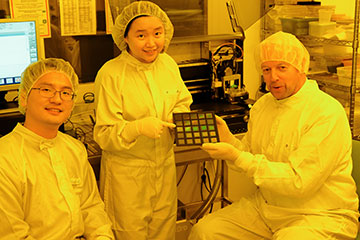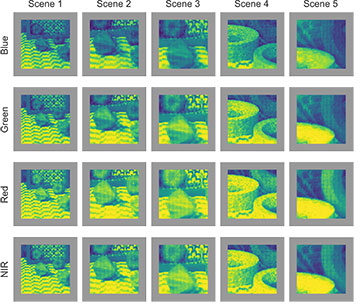
The research team is shown with inkjet-printed color filters. [Image: Jan Feβler, Karlsruhe Institute of Technology]
Researchers at a German university have invented a handheld multispectral light-field camera that collects 3D images and spectral data in one snapshot (Opt. Express, doi: 10.1364/OE.521646). Key to the simultaneous spectral and spatial data capture are arrays of microlenses and inkjet-printed color filters precisely aligned on a single substrate.
The printed optical arrays fit easily into a handheld camera body, and the scientists say that wide-ranging uses for the compact device could include autonomous vehicles, endoscopy and other medical imaging, materials separation and even consumer electronics.
Getting all five dimensions
Mathematically, the plenoptic function represents all light flow at every point in space within a scene, in five dimensions. However, an ordinary camera doesn’t capture all five dimensions at once. Until now, capturing spatial and spectral information together has required two camera systems: one for spectral data, which has trouble with dynamic scenes, and another that records 3D images but cannot process spectra.

The team used a new camera and deep-learning method to produce these reconstructed views in different color channels (false-color representation). [Image: Maximilian Schambach, Karlsruhe Institute of Technology]
In recent years, scientists have tried to combine spectral and 3D imaging functions in a single unit, but complications have arisen. In one example, the color filter arrays and microlenses must be aligned one pixel at a time, which leads to bulkiness and design complexity.
The team at the Karlsruhe Institute of Technology figured out that inkjet printing is a highly accurate way to achieve permanent alignment between the microlenses and the color filter arrays inside a multispectral ligh- field camera.
Fabrication and testing
Karlsruhe team leader Uli Lemmer and his colleagues first created microlenses by laying down a dense array of droplets on one side of a substrate. Surface tension caused the droplets to form spherical lens shapes as they cured. The highly uniform microlenses had an average radius of 31.37 μm.
Once the lens array was in place, the researchers laid down acrylic color filters on the other side of the substrate. “The precise registration between two arrays with more than ten thousand elements posed a challenge for conventional methods,” the team wrote. Again, the inkjet printer deposited tiny circles of material treated with four dyes, one each for red, green, blue and near-infrared.
The fully assembled camera, including an integrated CMOS chip, had a spatial resolution of 96 × 96 and an angular resolution of 9 × 9. The researchers tested their camera by capturing a scene that had many colored 3D objects spaced at varying distances. They then used deep-learning algorithms to help extract data and create reconstructed images.
“Tackling the challenge of creating a multispectral light-field camera was only possible by combining recent advances from manufacturing, system design and AI-based image reconstruction,” said first author Qiaoshuang Zhang in a press release. “This work pushes the boundaries of inkjet printing—a versatile method with high precision and industrial scalability—for manufacturing photonic components.”
